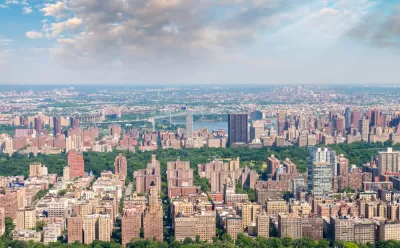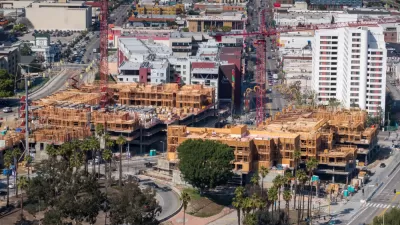Size and growth go hand in hand, until they don't, according to a new analysis. Density might be the reason that synergy eventually shortcircuits.

Richard Florida shares insights about a new study by Jordan Rappaport of the Federal Reserve Bank of Kansas City examining the size and density of metropolitan areas for lessons in growth.
On one hand, size (in terms of population and employment) is a huge advantage. Bigger places inexorably grow bigger. And this is especially true for relatively large cities (up to 500,000 people) with plenty of space to grow. For these places, their initially large populations beget faster growth over time.
But, on the other hand, density cuts the other way and can slow growth for very large places. This would seem to be at odds with urban theories from Jane Jacobs and others, that view density and clustering as an essential spur to innovation. But Rappaport finds that density generates diseconomies like traffic congestion or expensive housing costs, which limit growth.
To produce these findings, Rappaport examined job and population data for "more than 2,000 American communities, including more than 350 metropolitan areas, 554 micropolitan areas, and 1,300 “non-core” counties," explains Florida. Florida supplements the article with infographics pulled to further illustrate the points made in the study.
FULL STORY: How Density Can Deter Growth in America’s Largest Metros

Alabama: Trump Terminates Settlements for Black Communities Harmed By Raw Sewage
Trump deemed the landmark civil rights agreement “illegal DEI and environmental justice policy.”

Study: Maui’s Plan to Convert Vacation Rentals to Long-Term Housing Could Cause Nearly $1 Billion Economic Loss
The plan would reduce visitor accommodation by 25% resulting in 1,900 jobs lost.

Why Should We Subsidize Public Transportation?
Many public transit agencies face financial stress due to rising costs, declining fare revenue, and declining subsidies. Transit advocates must provide a strong business case for increasing public transit funding.

Paris Bike Boom Leads to Steep Drop in Air Pollution
The French city’s air quality has improved dramatically in the past 20 years, coinciding with a growth in cycling.

Why Housing Costs More to Build in California Than in Texas
Hard costs like labor and materials combined with ‘soft’ costs such as permitting make building in the San Francisco Bay Area almost three times as costly as in Texas cities.

San Diego County Sees a Rise in Urban Coyotes
San Diego County experiences a rise in urban coyotes, as sightings become prevalent throughout its urban neighbourhoods and surrounding areas.
Urban Design for Planners 1: Software Tools
This six-course series explores essential urban design concepts using open source software and equips planners with the tools they need to participate fully in the urban design process.
Planning for Universal Design
Learn the tools for implementing Universal Design in planning regulations.
Smith Gee Studio
Alamo Area Metropolitan Planning Organization
City of Santa Clarita
Institute for Housing and Urban Development Studies (IHS)
City of Grandview
Harvard GSD Executive Education
Toledo-Lucas County Plan Commissions
Salt Lake City
NYU Wagner Graduate School of Public Service





























